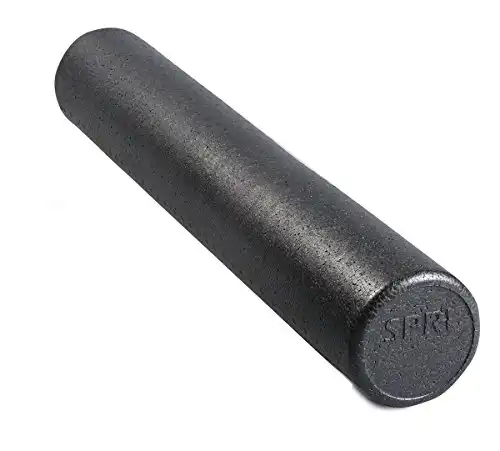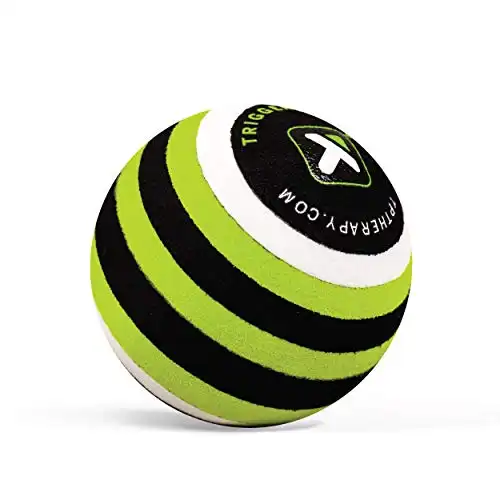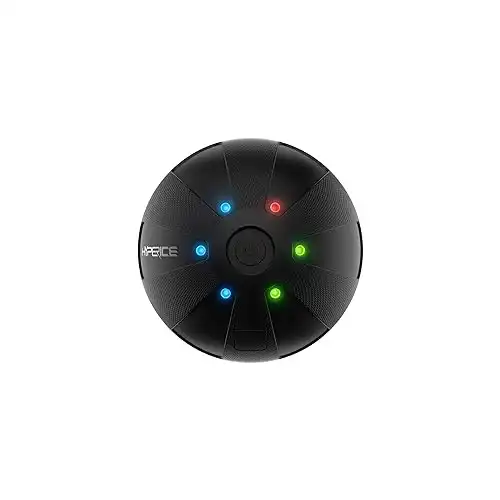This post contains affiliate links. Please see our disclosure policy.
Discover 7 amazing benefits of foam rolling for muscle recovery, flexibility, and pain relief. This complete beginner’s guide teaches you how to start and maximize results!
Foam rolling has so many benefits and is popular amongst physical therapists and athletes to maximize muscle recovery.
True to the name, it’s simply a roll of foam that is used for a self-myofascial release technique, that is much more affordable and convenient than deep tissue massages.
Foam rolling has gained popularity in recent years as more research reveals the incredible benefits it provides for the body.
I personally try to foam roll two to three times a week and I’ve noticed a difference in my daily movement.
Let’s take a look at some of the amazing benefits of foam rolling, and how to get started with this simple but powerful tool!
Table of contents
1. Loosens Stiff Muscles
One of the major benefits of foam rolling is that you can use it to loosen stiff muscles so you can get the most out of your workouts, and focus on your recovery too.
Ever gone from lounging on the couch to hitting the pavement for a jog without taking the time to properly warm up? You’ve likely felt extremely stiff.
Foam rolling is a great way to get blood flowing and loosen up your muscles before a workout so you feel good and your movement feels comfortable.
One study conducted by the National Strength & Conditioning Association concluded that athletes who took advantage of foam rolling before exercising felt much less fatigued than those who chose not to foam roll.
2. Can Reduce Stress
Foam rolling helps relax tight muscles and release tension, promoting a calming effect that can reduce overall stress levels.
High levels of stress can take a toll on your health, especially if you’re trying to lose weight and get in shape. Constant stress is linked to increased hormones such as cortisol that increase appetite, promote weight gain and fat storage, and disrupt your sleep.
One university study from South Korea found that foam rolling can lower levels of the stress hormone cortisol.
3. Helps Prevent Injury
Another benefit of foam rolling is that it helps to improve muscle elasticity and addresses imbalances, minimizing the risk of strains and injuries during physical activity.
Injury prevention isn’t just about being careful, but about being proactive.
A consistent routine of stretching and foam rolling can help keep pesky and painful injuries linked with tightness and overuse, as the iliotibial band, at bay by loosening up the muscles.
Studies have shown that loosening up your muscles increases the compliance of the muscle-tendon unit. This prevents the body from demanding energy absorption and release that can exceed the capacity of the muscle-tendon unit that leading to injury.
4. Limits Soreness
Regular foam rolling aids in breaking up lactic acid buildup, which can reduce post-workout soreness and speed up recovery.
By increasing flexibility and blood flow, foam rolling can inhibit soreness.
A 2015 study conducted by the National Athletic Trainer’s Association concluded that foam rolling was significantly effective in lessening muscle fatigue and soreness.
5. Can Increase Flexibility
Foam rolling releases fascial adhesions, making muscles more pliable and enhancing overall flexibility.
Loosening up your muscles through foam rolling can boost their elasticity. The more flexible the muscles, the more power they can produce. In fact, a 2014 study found that foam rolling even increased an athlete’s range of motion.
You can also check out my top 10 stretches to improve flexibility after middle age for more tips!
6. Boosts Blood Circulation
Another benefit of foam rolling is that it stimulates blood flow, delivering oxygen and nutrients to muscles for better recovery and performance.
Proper blood circulation is important on a multitude of levels.
Massages work to improve circulation through the arteries, veins, and capillaries in your body, which allows them to receive more oxygen to feel refreshed.
One study conducted by the National Athletic Trainer’s Association found that arterial stiffness was decreased while the vascular endothelial function was increased after using a foam roller.
7. Can Increase Range of Motion
By loosening tight muscles and connective tissue, foam rolling improves joint mobility and enhances the range of motion during movement.
A 2010 study from the Centers for Disease Control and Prevention concluded that the range of motion in every major joint in the body decreases with age. This can cause everyday tasks to feel painful.
Decreased range of motion can also lead to injury.
Foam rolling has been found to increase range of motion and, compared to static stretching before a workout, can increase muscle force according to a 2014 study published in the International Journal of Sports Physical Therapy.
How to Get Started Using a Foam Roller
Now that we’ve covered the benefits of roam rolling, let’s dive into how to get started with foam rolling to improve recovery, flexibility, and mobility. These beginner-friendly tips, techniques, and essential steps will help you get started with foam rolling today!
Understand the Two Main Types of Foam Rolling Techniques
There are two main foam rolling techniques you can use: static pressure and dynamic rolling.
| Static Pressure | This technique involves finding a tender or tight spot in the muscle and holding the foam roller in place on that area for 20–30 seconds. The sustained pressure helps release tension, improve blood flow, and relax the muscle. It’s especially useful for addressing specific trigger points or knots. |
| Dynamic Rolling | This method involves slowly rolling the foam roller back and forth over a muscle group, typically in 1–2 inch movements. It helps warm up the tissue, increase circulation, and prepare the muscles for activity or recovery. Use this technique to target larger muscle areas like the quads, hamstrings, or back. |
How To Use A Foam Roller
Here are the steps I recommend for getting started with your foam roller:
- Choose a flat surface and position the foam roller under the muscle group you want to target.
- Use your body weight to apply gentle pressure, rolling slowly back and forth over the area for 20–30 seconds.
- Focus on tight or sore spots, pausing briefly on tender areas to allow the tension to release. When you find a sore trigger point—pin it, hold it, lean into it, and add pressure.
- Add cross friction by kneading back and forth across the muscles.
Remember to keep your movements controlled and avoid rolling directly over joints or bony areas to prevent discomfort.
A typical method to ensure you hit all the major muscle groups is to go from the bottom up: Start with the calves, then your hamstrings, then the glutes.
Where to Buy Your Foam Roller
The best thing about foam rollers is that they are not expensive! These are the best foam rollers on Amazon:
- High Density (different length) Foam Roller
- Trigger Point Foam Roller
- Medium Density Foam Roller
- Electric Foam Roller
- Trigger Point Massage Ball – I use this every morning for my low back pain routine. Great for targeted areas!
- Hyperice Sphere Massage Ball
- Massage Roller Stick
| Product Image | Product Name | Primary Button |
|---|---|---|
Foam Rolling Exercises to Get Started With
Now you know all the benefits of foam rolling, it’s time to get started with some simple foam rolling exercises.
You can check out my 6 foam roller moves to loosen tight muscles, or check out the individual exercises below:
- Foam Roller Back Roll (targets back muscles)
- Foam Roller Lat Roll (targets upper back muscles)
- Foam Roller Hamstring Roll (targets hamstring muscles)
- Foam Roller Calf Roll (targets calf muscles)
- Foam Roller Quad Roll (targets quad muscles)
- Foam Roller IT Band (targets tight IT bands and hips)






